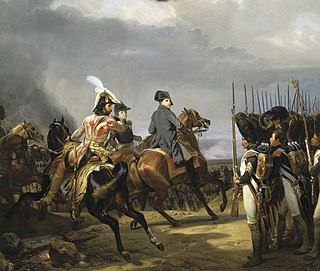
The twin battles of Jena and Auerstedt were fought on 14 October 1806 on the plateau west of the river Saale in today's Germany, between the forces of Napoleon I of France and Frederick William III of Prussia. The defeat suffered by the Prussian Army subjugated the Kingdom of Prussia to the French Empire until the Sixth Coalition was formed in 1813.

The Fourth Coalition fought against Napoleon's French Empire and were defeated in a war spanning 1806–1807. The main coalition partners were Prussia and Russia with Saxony, Sweden, and Great Britain also contributing. Excluding Prussia, some members of the coalition had previously been fighting France as part of the Third Coalition, and there was no intervening period of general peace. On 9 October 1806, Prussia declared war on France and joined a renewed coalition, fearing the rise in French power after the defeat of Austria and establishment of the French-sponsored Confederation of the Rhine in addition to having learned of French plans to cede Prussian-desired Hannover to Britain in exchange for peace. Prussia and Russia mobilized for a fresh campaign with Prussia massing troops in Saxony.

Charles William Ferdinand was the Prince of Brunswick-Wolfenbüttel and Duke of Brunswick-Lüneburg and a military leader. His titles are usually shortened to Duke of Brunswick in English-language sources.

Frederick William, Duke of Brunswick-Wolfenbüttel, was a German prince and Duke of Brunswick-Lüneburg and Oels. Nicknamed "The Black Duke", he was a military officer who led the Black Brunswickers against French domination in Germany. He briefly ruled the state of Brunswick-Wolfenbüttel from 1806 to 1807 and again from 1813 to 1815.
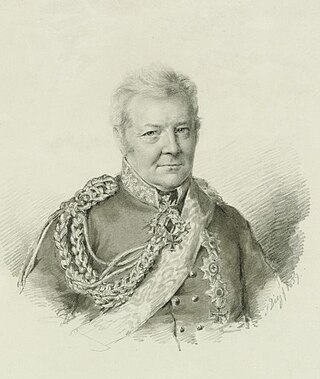
Karl Friedrich von dem Knesebeck was a Prussian field marshal and military adviser in the Napoleonic Wars, best known for designing the campaign plan of the Battle of the Nations and the subsequent invasion of France. As aide-de-camp to the king from 1813, and thereby his closest military advisor, he was a key figure in Prussia's military policy throughout the War of the Sixth Coalition and the subsequent Congress of Vienna.

Anton Wilhelm von L'Estocq was a Prussian cavalry general best known for his command of the Prussian troops at the Battle of Eylau.
Julius August Reinhold von Grawert (1746–1821) was a Prussian general. During the Battle of Jena-Auerstedt on 14 October 1806, he led a division under Frederick Louis, Prince of Hohenlohe-Ingelfingen at Jena. As Generalleutnant, Grawert commanded the Prussian auxiliary corps attached to French Emperor Napoleon I's Grande Armée during the French invasion of Russia. Grawert was replaced by Ludwig Yorck von Wartenburg in 1812. He retired in 1820 to Silesia.

Karl Ludwig August Friedrich von Phull was a German general in the service of the Kingdom of Prussia and the Russian Empire. Phull served as Chief of the General Staff of King Frederick William III of Prussia in the Battle of Jena-Auerstedt. While in Russian service, he successfully advocated for a scorched earth policy during Napoleon's invasion of Russia.
Karl Adolf von Strotha was a Prussian officer and Minister of War from 1848 to 1850.
Graf August Karl Wilhelm von Kanitz was a Prussian Lieutenant General and was also the Minister of War from 26 April to 16 June 1848 in the Camphausen-Hansemann government.
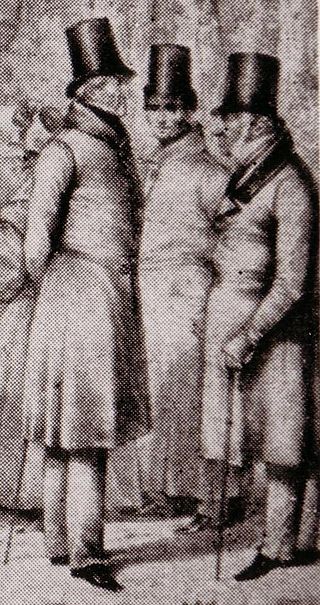
Karl Ernst Job Wilhelm von Witzleben was a Prussian lieutenant general, adjutant-general to the king, and minister of war.
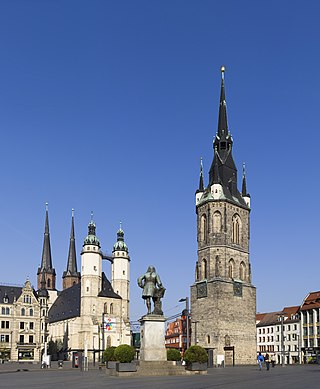
In the Battle of Halle on 17 October 1806 a French corps led by Jean-Baptiste Bernadotte fought the Prussian Reserve under Eugene Frederick Henry, Duke of Württemberg. The French defeated their opponents, forcing the Prussians to retreat northeast toward Dessau after suffering heavy losses. The clash occurred in the War of the Fourth Coalition, part of the Napoleonic Wars. The city of Halle is located about 30 kilometers northwest of Leipzig on the Saale River.

Ernst von Rüchel was a Prussian general who led an army corps in a crushing defeat by Napoleon at the Battle of Jena on 14 October 1806. He commanded troops from the Kingdom of Prussia in several battles during the French Revolutionary Wars in 1793 and 1794. Afterward he held various appointments as a diplomat and a military inspector. In 1806 during the Napoleonic Wars he held an important army command but has been criticized for his actions at Jena. Wounded, he managed to escape the French pursuit, but never commanded troops in combat again.

In the Capitulation of Erfurt on 16 October 1806, a large body of troops from the Kingdom of Prussia under Lieutenant General the Prince of Orange surrendered to Marshal Joachim Murat of France, at the city of Erfurt. The Prussian soldiers were demoralized by their shattering defeat at the Battle of Jena–Auerstedt on 14 October and unwilling to put up much resistance. The event occurred during the War of the Fourth Coalition, part of the Napoleonic Wars. Erfurt is located on the Gera River about 40 kilometers west of Jena.

In the Battle of Prenzlau or Capitulation of Prenzlau on 28 October 1806 two divisions of French cavalry and some infantry led by Marshal Joachim Murat intercepted a retreating Prussian corps led by Frederick Louis, Prince of Hohenlohe-Ingelfingen. In this action from the War of the Fourth Coalition, Hohenlohe surrendered his entire force to Murat after some fighting and a parley. Prenzlau is located about 90 kilometers north of Berlin in Brandenburg.

The Capitulation of Pasewalk on 29 October 1806 resulted in the surrender of Oberst (Colonel) von Hagen's 4,200 Prussian soldiers to an inferior force of two French light cavalry brigades led by Generals of Brigade Édouard Jean Baptiste Milhaud and Antoine Lasalle. The Prussians were completely demoralized after a two-week-long retreat following their decisive defeat at the Battle of Jena-Auerstedt. Pasewalk is 110 kilometers north of Berlin and about 40 kilometers west of Szczecin (Stettin), Poland.
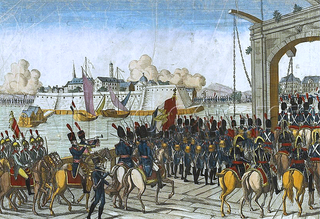
In the Capitulation of Stettin on 29–30 October 1806, Lieutenant General Friedrich Gisbert Wilhelm von Romberg surrendered the garrison and fortress to a much smaller French light cavalry brigade led by General of Brigade Antoine Lasalle. This event was one of a number of surrenders by demoralized Prussian soldiers to equal or inferior French forces after their disastrous defeat at the Battle of Jena-Auerstedt on 14 October. Stettin, now Szczecin, Poland, is a port city on the Oder River near the Baltic Sea, about 120 kilometres (75 mi) northeast of Berlin.
Karl Ludwig von Lecoq or Karl Ludwig von Le Coq, born 23 September 1754 – died 14 February 1829, of French Huguenot ancestry, first joined the army of the Electorate of Saxony. He later transferred his loyalty to the Kingdom of Prussia and fought during the French Revolutionary Wars, earning a coveted award for bravery. While serving variously as a staff officer and diplomat, he became renowned as an expert cartographer. In 1806 he was entrusted with command of the forces in northwest Germany. Cut off from the main body of the Prussian army after the disaster at the Battle of Jena-Auerstedt, he concentrated his troops in the fortress of Hameln. After a brief siege, he surrendered his troops to an inferior force of enemies. For this, he was sentenced to life imprisonment. However, he was later pardoned and continued his map-making until he went blind.

Samuel Graf von Schmettau was a Prussian field marshal, artilleryman, and cartographer.

Johann Bonaventura von Rauch was a Prussian Army major general. His sons Gustav, Leopold and Friedrich Wilhelm also took up military careers and became general as well.

















